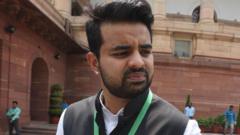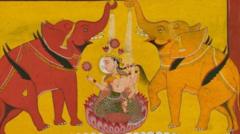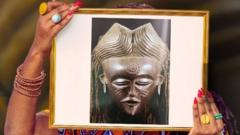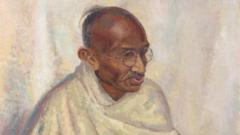As artists and curators work together, they aim to reconnect the public with the country's vibrant weaving traditions and the stories behind them.
Reviving India's Rich Textile Heritage Through Art Exhibitions

Reviving India's Rich Textile Heritage Through Art Exhibitions
Innovative exhibitions across India highlight the importance and diversity of local textiles.
In recent months, a wave of exhibitions across India has been shedding light on the country's rich textile heritage, focusing on lesser-known traditions that have long been overshadowed by popular fashion narratives. One such exhibition, "Gamchha: From the Ordinary to the Extraordinary," recently showcased over 250 variations of the gamchha—a traditional scarf made from red-and-white checked fabric—exhibiting its diverse interpretations across 14 Indian states. Notably highlighted by textiles expert Jaya Jaitly, the exhibition underscores the need to include these essential local fabrics in the broader conversation about Indian textiles, often sidelined despite their cultural significance.
It reflects a conscious shift away from the glitzy glamour of urban fashion, opting instead to elevate local artisans and their traditional crafts that embody rich histories. Curators and researchers, collaborating with community artisans, are reinvigorating the dialogue around textiles, moving from a narrow focus on elaborate ceremonial garments to a more inclusive exploration of everyday materials and the artisan stories they carry.
As Ritu Sethi, founder of the Crafts Revival Trust, aptly puts it, a "technology-prompted egalitarianism" is emerging with the advent of digital platforms, allowing craftspeople to find visibility and recognition. Interestingly, renowned designer David Abraham articulates that these exhibitions not only celebrate traditional textiles but foster a deeper cultural pride among Indians who communicate their identity through fabric and weave.
In Kolkata, the exhibition "Textiles of Bengal: A Shared Legacy" continues to unfold, inviting visitors to explore historic fabrics dating back to the 17th century, including extraordinary Indo-Portuguese embroideries. The event champions the interconnectedness of Bengal's textile traditions with neighboring Bangladesh, emphasizing a shared cultural history.
In another remarkable display, “Pampa: Textiles of Karnataka” introduced attendees to the art of embroidery from local nomadic tribes and sacred textile practices reflecting the lives of agrarian communities. Here, textiles serve not merely as artistry but as storytelling devices for marginalised groups within society.
Moreover, exhibitions are not limited to historical contexts; they are also looking towards the future. "Surface: An Exhibition of Indian Embroideries and Surface Embellishment as Art" showcased textiles as art in themselves, transforming traditional techniques into contemporary expressions within various art forms.
As organizations across India work to establish meticulous documentation of textile traditions, they aim to fill gaps in continuity that often leave new generations in the dark regarding their cultural heritage. With notable projects like "Pehchaan: Enduring Themes in Indian Textiles," initiated by the Devi Art Foundation, there is hope that younger designers will be inspired by their roots.
The growing success of these initiatives offers potential for a blossoming future in the textile arts, encouraging new partnerships among curators and the rising generation of artists and artisans, aiming for quality and authenticity in their creative endeavors. As Mayank Mansingh Kaul, a curatorial advisor to over 20 exhibitions, emphasizes, this renaissance can cultivate new audiences eager to reconnect with India's rich textile legacy.
It reflects a conscious shift away from the glitzy glamour of urban fashion, opting instead to elevate local artisans and their traditional crafts that embody rich histories. Curators and researchers, collaborating with community artisans, are reinvigorating the dialogue around textiles, moving from a narrow focus on elaborate ceremonial garments to a more inclusive exploration of everyday materials and the artisan stories they carry.
As Ritu Sethi, founder of the Crafts Revival Trust, aptly puts it, a "technology-prompted egalitarianism" is emerging with the advent of digital platforms, allowing craftspeople to find visibility and recognition. Interestingly, renowned designer David Abraham articulates that these exhibitions not only celebrate traditional textiles but foster a deeper cultural pride among Indians who communicate their identity through fabric and weave.
In Kolkata, the exhibition "Textiles of Bengal: A Shared Legacy" continues to unfold, inviting visitors to explore historic fabrics dating back to the 17th century, including extraordinary Indo-Portuguese embroideries. The event champions the interconnectedness of Bengal's textile traditions with neighboring Bangladesh, emphasizing a shared cultural history.
In another remarkable display, “Pampa: Textiles of Karnataka” introduced attendees to the art of embroidery from local nomadic tribes and sacred textile practices reflecting the lives of agrarian communities. Here, textiles serve not merely as artistry but as storytelling devices for marginalised groups within society.
Moreover, exhibitions are not limited to historical contexts; they are also looking towards the future. "Surface: An Exhibition of Indian Embroideries and Surface Embellishment as Art" showcased textiles as art in themselves, transforming traditional techniques into contemporary expressions within various art forms.
As organizations across India work to establish meticulous documentation of textile traditions, they aim to fill gaps in continuity that often leave new generations in the dark regarding their cultural heritage. With notable projects like "Pehchaan: Enduring Themes in Indian Textiles," initiated by the Devi Art Foundation, there is hope that younger designers will be inspired by their roots.
The growing success of these initiatives offers potential for a blossoming future in the textile arts, encouraging new partnerships among curators and the rising generation of artists and artisans, aiming for quality and authenticity in their creative endeavors. As Mayank Mansingh Kaul, a curatorial advisor to over 20 exhibitions, emphasizes, this renaissance can cultivate new audiences eager to reconnect with India's rich textile legacy.



















